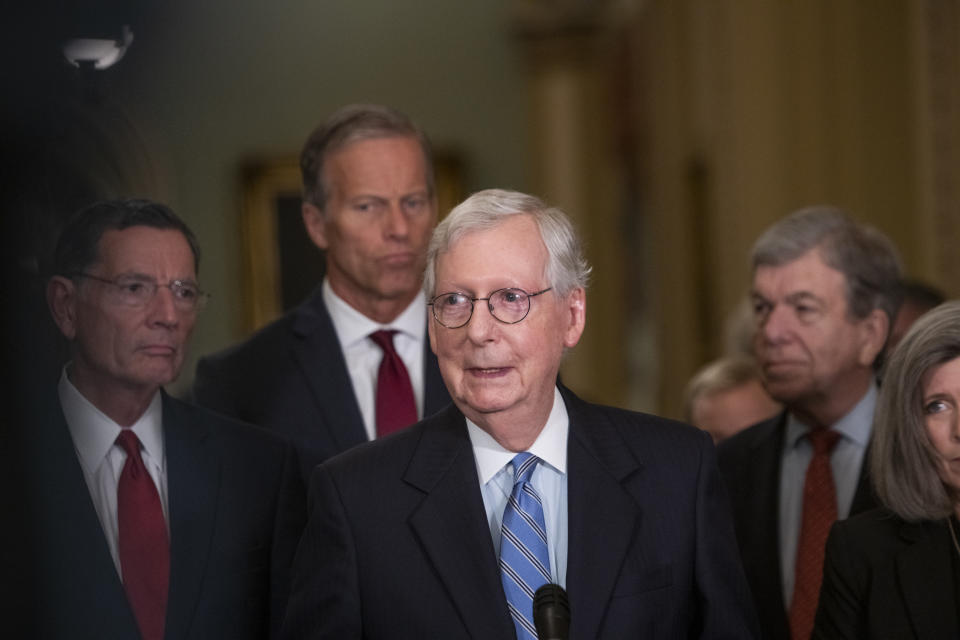14 GOP Senators Back McConnell-Schumer Deal to Raise Debt Ceiling

The Senate on Thursday cleared a procedural hurdle necessary to allow Democrats to raise the debt ceiling and avert a potentially catastrophic default through a simple majority vote.
Fourteen Republicans joined all 50 Senate Democrats in advancing a bill to create a one-time, fast-track process for raising the federal government’s borrowing limit, part of an unusual, two-step plan agreed to by Senate Majority Leader Chuck Schumer (D-NY) and Minority Leader Mitch McConnell (R-KY). The bill also would prevent cuts to Medicare and other programs.
The Republicans who backed the compromise plan: Besides McConnell, the 13 other Republicans who backed the plan to let Democrats raise the debt ceiling were John Barrasso of Wyoming; Roy Blunt of Missouri; Richard Burr of North Carolina; Susan Collins of Maine; John Cornyn of Texas; Joni Ernst of Iowa; Shelley Moore Capito of West Virginia; Lisa Murkowski of Alaska; Rob Portman of Ohio; Mitt Romney of Utah; John Thune of South Dakota; Thom Tillis of North Carolina and Roger Wicker of Mississippi.
What’s next: A final Senate vote to approve the fast-track process is expected later Thursday or Friday, and the bill would then go to President Biden’s desk. Once Biden signs it into law, Democrats in the House and Senate would be able to pass a separate bill to actually raise the debt limit to a specific dollar amount. That vote is expected early next week, ahead of December 15, the date by which the Treasury Department has said it might not be able to meet its obligations.
"This is the responsible path forward — no brinksmanship, no default on the debt, no risk of another recession," Schumer said on the Senate floor before the procedural vote. "We still have a few more steps to take before we completely resolve this matter, but I'm optimistic that after today's vote, we'll be on a glide path to avoid a catastrophic default."
And Thune, a member of GOP leadership, indicated to reporters that lawmakers are cooperating to be able move ahead, even as some Republicans have criticized McConnell’s deal, warning that it could set a bad precedent for waiving the Senate’s filibuster rule. "I think everybody has an understanding of how this is probably going to end and wants to get it wrapped up in a timely way," Thune said.
How high will the new ceiling be? Democrats haven’t yet revealed the dollar figure for the new debt limit, but it’s reportedly likely to be over $30 trillion, high enough so that lawmakers don’t have to raise it again before the 2022 midterm elections. “One Treasury estimate suggested they would need to raise it by as much as $2.5 trillion to cover that period,” Emily Cochrane reports at The New York Times, citing a person familiar with the preliminary accounting.
Blunt, the Missouri Republican, said the new ceiling “will be a shock to the system for everybody — and anybody in the country who really can grasp a trillion dollars.” He also told reporters that the end result here — Democrats voting on their own to raise the limit — means McConnell is “getting exactly what he wanted,” albeit not necessarily in the way the GOP leader would have preferred.
Raising the debt limit has traditionally been handled in a bipartisan manner, but McConnell pressed Democrats to raise the limit on their own via the reconciliation process they are looking to use to pass their $1.7 trillion social spending and climate plan. Democrats insisted they wouldn’t go that route because it was too cumbersome, time-consuming and risky.
The compromise hammered out this week lets Congress steer clear of a default while still allowing Republicans to vote no on raising the debt limit, helping them to continue their campaign attacks on Democratic spending plans. (Democrats, on the other hand, may get to again campaign as the responsible grown-ups in Congress, though it’s not completely clear how much the American public cares about such things.)
